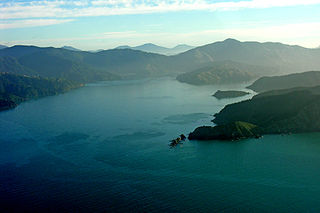| |||||
| Decades: | |||||
|---|---|---|---|---|---|
| See also: | |||||
The following lists events that happened during 1839 in New Zealand.
| |||||
| Decades: | |||||
|---|---|---|---|---|---|
| See also: | |||||
The following lists events that happened during 1839 in New Zealand.

The New Zealand Company, chartered in the United Kingdom, was a company that existed in the first half of the 19th century on a business model that was focused on the systematic colonisation of New Zealand. The company was formed to carry out the principles devised by Edward Gibbon Wakefield, who envisaged the creation of a new-model English society in the Southern Hemisphere. Under Wakefield's model, the colony would attract capitalists, who would then have a ready supply of labour: migrant labourers who could not initially afford to be property owners but would have the expectation of one-day buying land with their savings.

Colonel William Hayward Wakefield was an English officer of the British Auxiliary Legion, and the leader of the second New Zealand Company's first colonising expedition to New Zealand; one of the founders of Wellington city. As a leader, he attracted much controversy.
Richard Barrett (1807–1847) was one of the first European traders to be based in New Zealand. He lent his translation skills to help negotiate the first land purchases from Maori in New Plymouth and Wellington and became a key figure in the establishment of the settlement of New Plymouth. He was described by Edward Jerningham Wakefield, son of New Zealand Company founder Edward Gibbon Wakefield, as short, stout and "perfectly round all over" and fond of relating "wild adventures and hairbreadth 'scapes".
1840 is considered a watershed year in the history of New Zealand: The Treaty of Waitangi is signed, British sovereignty over New Zealand is proclaimed, organised European settlement begins, and Auckland and Wellington are both founded.
The following lists events that happened during 1838 in New Zealand.
The following lists events that happened during 1837 in New Zealand.
The following lists events that happened during 1836 in New Zealand.
The following lists events that happened during 1835 in New Zealand.
The following lists events that happened during 1831 in New Zealand.
John Guard was an English convict sent to Australia who was one of the first European settlers in the South Island of New Zealand, working as a whaler and trader.

Te Whanganui / Port Underwood is a sheltered harbour which forms the north-east extension of Te Koko-o-Kupe / Cloudy Bay at the northeast of New Zealand's South Island, on the east coast of the Marlborough Sounds. With only a relatively narrow entrance to the south-south-east it is sheltered from almost all winds. Originally considered part of Cloudy Bay, the port was named after Joseph Underwood of the shipping firm Kabel and Underwood in the early 19th century.
The following lists events that happened during 1830 in New Zealand.
The following lists events that happened during 1829 in New Zealand.
The following lists events that happened during 1827 in New Zealand.
The following lists events that happened during 1826 in New Zealand.
The following lists events that happened during 1823 in New Zealand.
The following lists events that happened during 1821 in New Zealand.
The following lists events that happened during 1820 in New Zealand.
There are still far fewer ships visiting New Zealand than before 1810. This is due to the economic depression which started in New South Wales in 1810 and continues until 1815. The concern that the Boyd massacre might be repeated abates somewhat as a number of reports that it was provoked reach Port Jackson. As more ships resume visits to the Bay of Islands they consistently report that they are well treated.
There is a new sealing rush to the Bounty and Auckland Islands. Sealing also continues at Bass Strait and the Antipodes Islands. Foveaux Strait is a frequent stop for these sealing ships. Whaling continues off the east coast of the North Island. Ships are now visiting the Bay of Islands on a reasonably regular basis. The first reports about the poor behaviour of visiting ship's crew are sent to the Church Missionary Society in London.